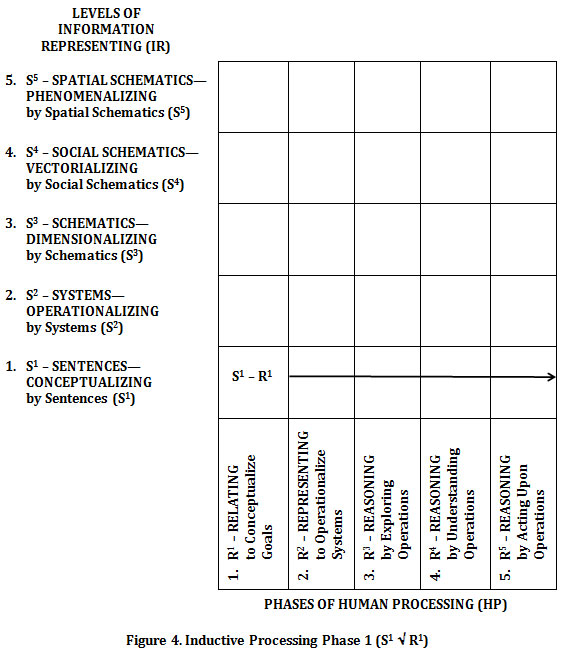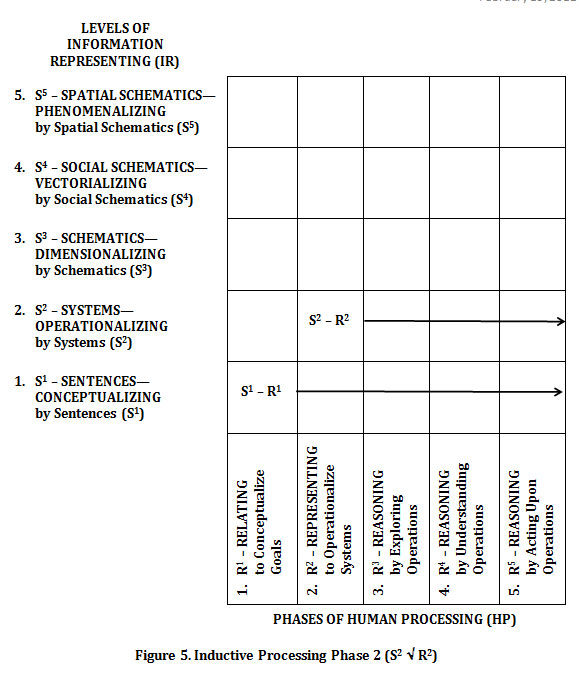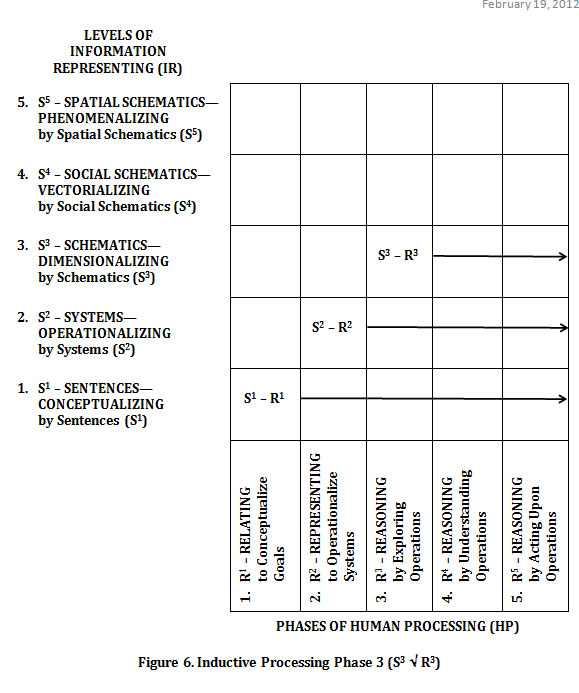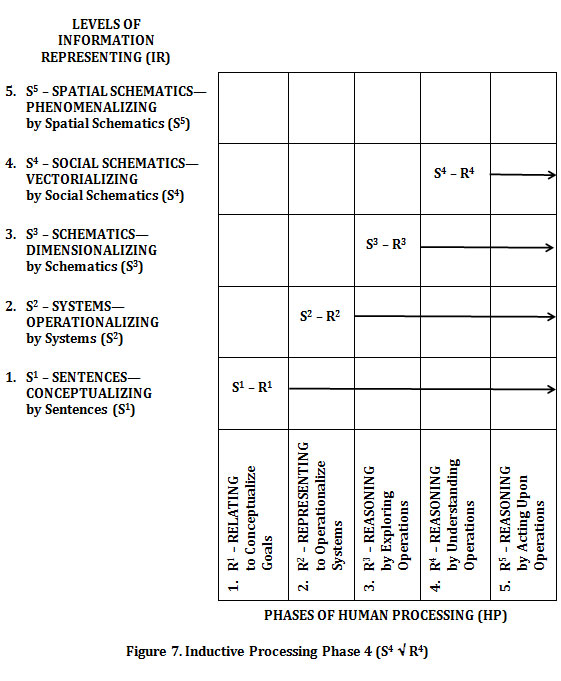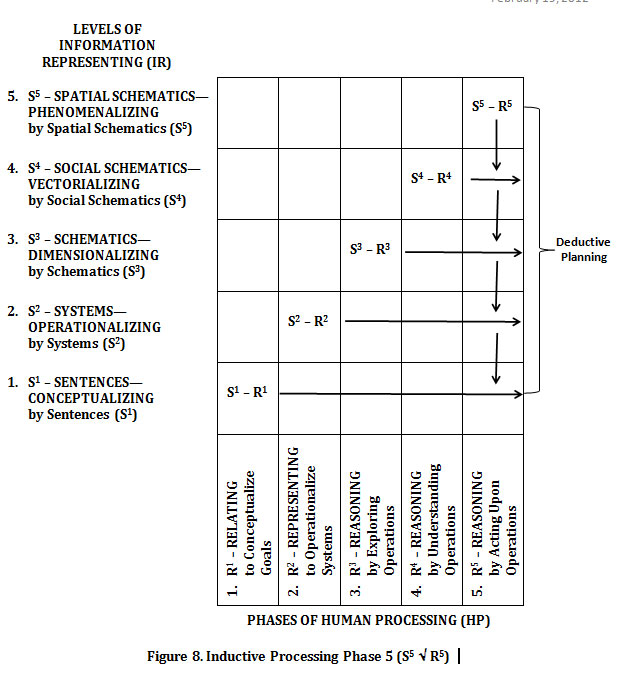Inductive Processing
Phase 1: Relating to Conceptualize Goals
In the first phase of inductive processing, the human processors relate to conceptualize their goals by sentences (S1 – R1) (see Figure 4). Without elevating to operationalize systems, their processing is predetermined, as illustrated (®). They will continue to conceptualize their functions as follows:
- Representing concepts,
- Exploring concepts,
- Understanding concepts,
- Acting upon concepts.
In other words, the processors are captive to their concepts. They will be unable to improve upon them, let alone act upon them, in a productive manner. At most, they can participate in extended conversations and attenuating discussions.
INDUCTIVE CASE STUDY (S1 – R1)
|
We may illustrate with a typical interpersonal case study from the living area. Parents’ pleas for cooperation from their teenage children have gone unheeded. In this case, the counselor responds by relating at the conceptual level of IR (S1 – I1): |
|
|
Counselor: |
“You feel overwhelmed by their delinquent behavior and their insolent responses.” |
|
Counselees: |
“It just seems that whatever we set up, they knock down.” |
|
Counselor: |
“You feel hopeless because they turn your love back on you.” |
|
Counselees: |
“They make us the bad guys.” |
While the processors perseverate in non-actionable conceptualization, they may begin to define their conceptual knowledge in operational terms. As may be noted, random successes in the achievement of specific objectives defines their goals in increasingly operational terms. While this processing is inefficient, it may become increasingly effective in conceptualizing goals.
Phase 2: Representing to Operationalize Systems
In the second phase of inductive processing, the human processors elect to represent their processing by operationalizing phenomenal systems (S2 – R2) (see Figure 5). By operationalizing their systems, their processing is elevated to actionable terms that will facilitate their processing in advanced phases:
- Reasoning by exploring through analyzing;
- Reasoning by understanding through synthesizing;
- Reasoning by acting through defining objectives.
In other words, the processors have met the necessary but not sufficient conditions of all generative processing: learning by acting. Without further elevation in processing, they can contribute to the linear movement of related systems (®).
INDUCTIVE CASE STUDY (S2 – R2)
|
In our continuing illustration with the distressed parents, the counselor may elevate his level of information representation: |
|
|
Counselor: |
“The way to overcome your helplessness is to set specific objectives of behavior and then reinforce them differentially according to their performance.” |
|
Counselees: |
“So if we set objectives for performance (S), then I can reward good behavior, punish bad behavior, and leave neutral behavior alone (R).” |
|
Counselor: |
“Both parents must be in agreement on the discriminations of the behavior and consistent on the administration of differential reinforcements.” |
While the processors continue in actionable systems operations, they begin to account for significant amounts of the variability in existing phenomena. As may be noted in the illustration, scales define the different levels of all dimensions in the phenomenal systems being addressed. While this processing is effective, it omits most of the variance accounted for by interactions within the dimensions of the phenomena.
Phase 3: Reasoning to Explore Operations
In the third phase of inductive processing, the human processors elevate their processing by schematically dimensionalizing or modeling phenomena (S3 – R3) (see Figure 6). By modeling phenomena, their processing is elevated to accounting for the powerful interactions within the phenomenal dimensions which will prepare them for culminating their processing in advanced phases:
- Reasoning by understanding through synthesizing;
- Reasoning by acting through defining objectives.
In other words, the processors have now expanded and analyzed the critical interactions within their phenomenal dimensions. They can now contribute further to the sources of effect of their primary phenomenal models (®).
INDUCTIVE CASE STUDY (S3 – R3)
|
In our continuing example with the anguished parents, the counselor may elevate his level of responsiveness to exploring the family operations involved: |
|
|
Counselee: |
“We don’t seem to be getting anywhere. I have a history of being laid back and my wife jumps on them for everything.” |
|
Counselor: |
“Each child has a history of reinforcements and each parent has a history of discriminating behavior and dispensing reinforcements.” |
|
Counselee: |
“Maybe that’s why we don’t click with our kids. We don’t click with each other. It’s like our kids are brought up inconsistently.” |
While the processors continue to study the interactive sources of effect within the phenomenal dimensions, they begin to discover the relationships between and among other phenomenal systems. They begin to address the basic “source questions” of phenomenal existence:
- Where did these basic functions come from?
Phase 4: Reasoning to Understand Operations
In the fourth phase of inductive processing, the human processors elevate their processing by generating social schematics for their phenomena (S4 – R4) (see Figure 7). By schematizing their models socially, their processing prepares them for the sources of effect of the phenomena being addressed:
- Reasoning by acting through defining objectives.
In other words, the processors have now narrowed and synthesized the critical sources of effect within, between, and among dimensions. They are now prepared to operationally define their objectives.
INDUCTIVE CASE STUDY (S4 – R4)
|
In our continuing illustration of parenting problems, the counselor may now elevate his level of responsiveness to further understanding of the family operations involved: |
|
|
Counselor: |
“In order to understand your generation of parenting, it will be helpful to understand its relationship to the generation you came from.” |
|
Father: |
“I was raised with ‘laissez faire’ child-rearing, so I’m kind of easy going.” |
|
Mother: |
“My history is one of discipline to achieve my objectives.” |
|
Father: |
“And the school just doesn’t seem to care!” |
|
Counselor: |
“So the kids are left conflicted about their goals and how to achieve them.” |
Since the processors continue to study the interactive sources of effect within, between, and among the dimensions, they are now prepared to answer the basic “cause” and “effect” questions of phenomenal existence.
Phase 5: Reasoning to Act Upon Operations
Finally, in the fifth phase of inductive processing, the human processors culminate their processing by generating spatial schematics for their phenomena (S5 – R5) (see Figure 8). By relating their models phenomenally or environmentally, their processing accounts for the projection of the consequences of their actions.
In other words, the processors have defined their objectives in terms of the operations needed for achievement. They are now ready to detail the plans to achieve these objectives ($).
INDUCTIVE CASE STUDY (S5 – R5)
|
In our concluding illustration of parenting problems, the counselor may now elevate his level of initiative to facilitate acting upon resolving the family operations: |
|
|
Counselor: |
“Maybe we can generate solutions by combining our contributions.” |
|
Mother: |
“Like relaxing when our standards are being met.” |
|
Father: |
“And setting objectives when they are not.” |
|
Mother: |
“The kids always prefer relaxing.” |
|
Father: |
“Then maybe they have to earn it.” |
|
Counselor: |
“So you’re beginning to see what differential reinforcement means.” |
|
Father: |
“Reward for success in goal achievement.” |
|
Mother: |
“And at least the absence of rewards for failure.”` |
|
Counselor: |
“It sounds like time for the family council.” |
Since the processors have defined all sources of effect, they are now ready to deductively plan to architect the sources of effectiveness. In so doing, they have also prepared a paradigm for deductive processing, ranging as follows:
- Reasoning by Phenomenalizing (S5 – R5)
- Reasoning by Vectorializing (S4 – R4)
- Reasoning by Dimensionalizing (S3 – R3)
- Reasoning by Operationalizing (S2 – R2)
- Reasoning by Conceptualizing (S1 – R1)
We are now ready to learn Deductive Processing.

